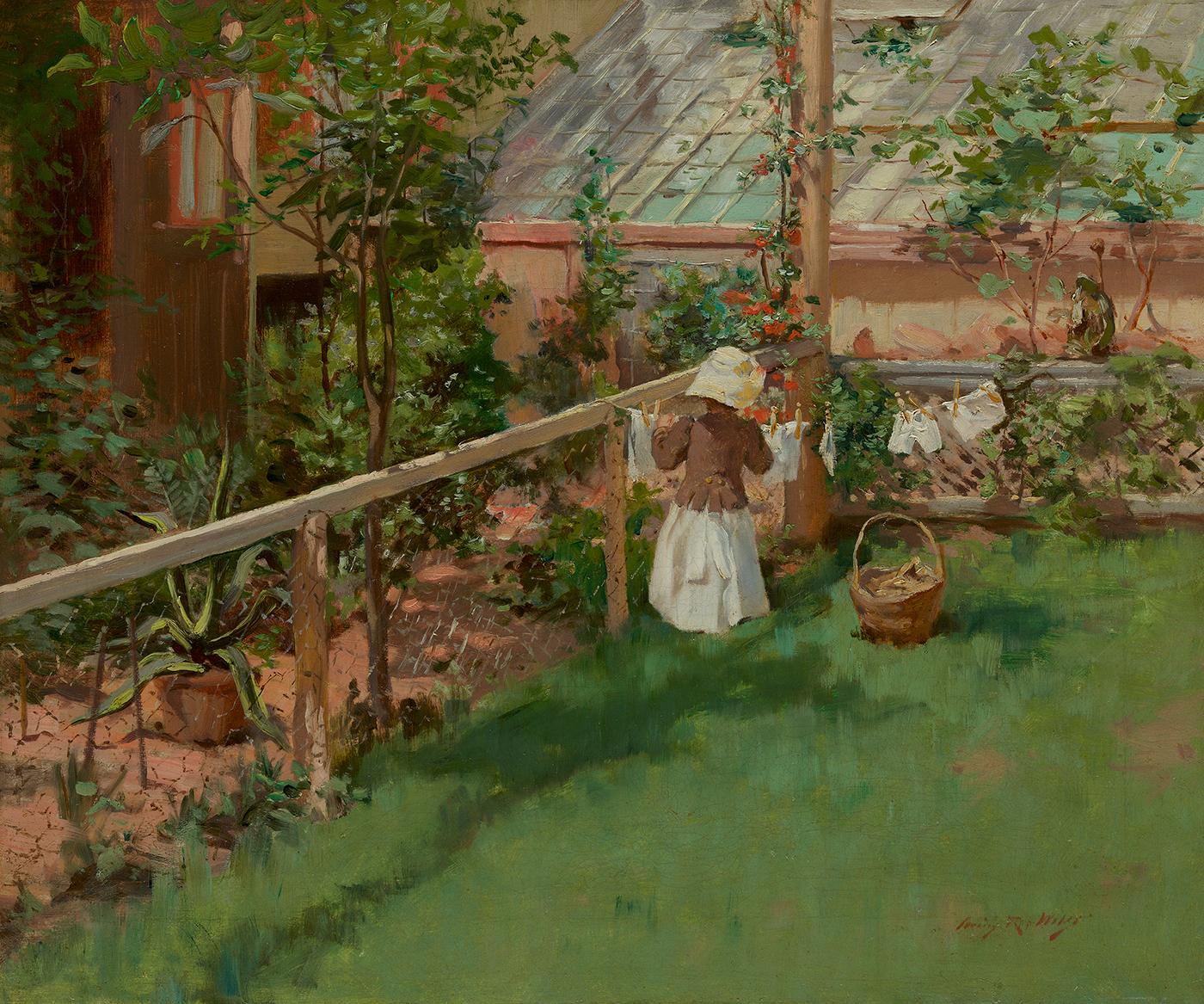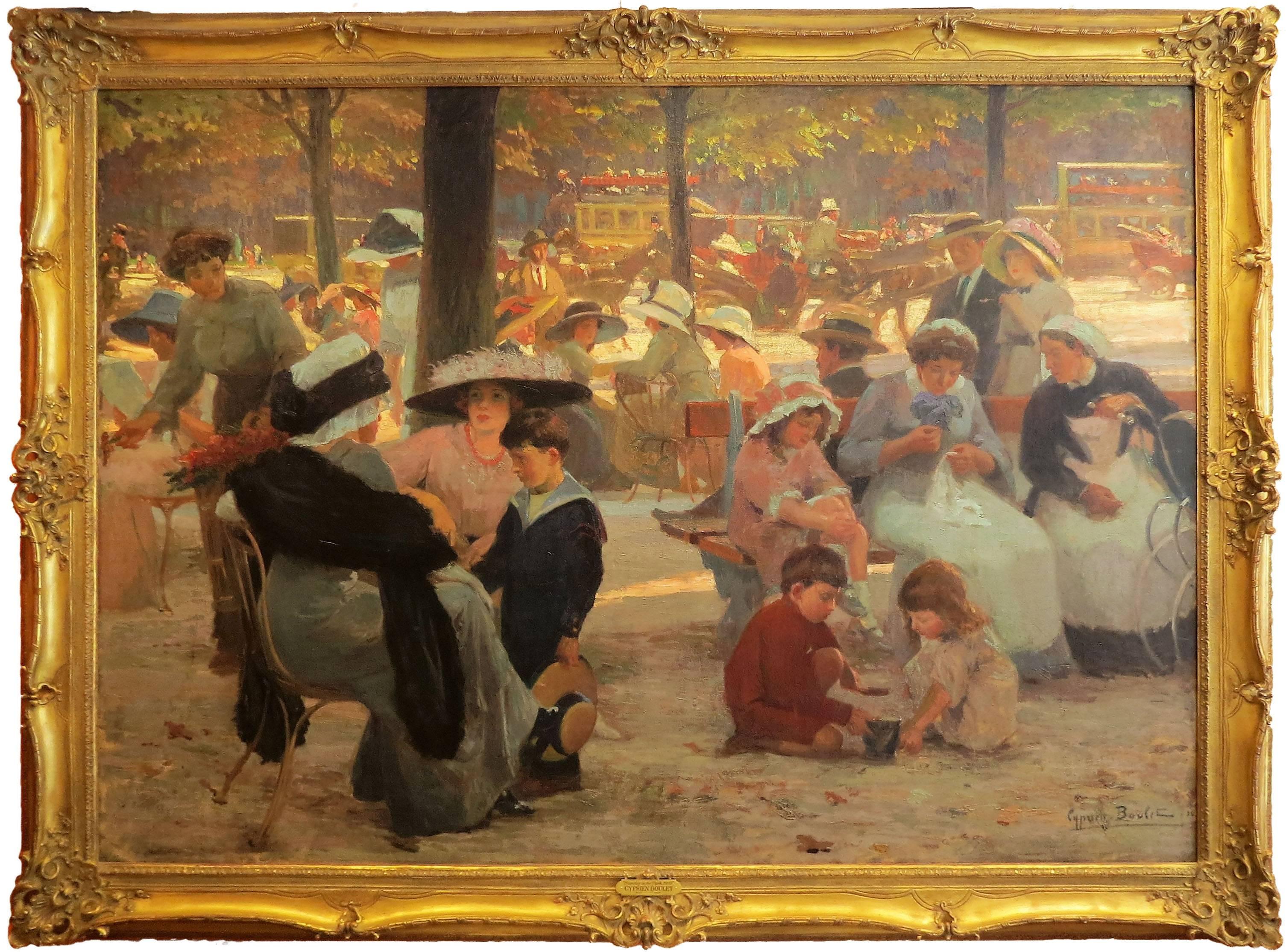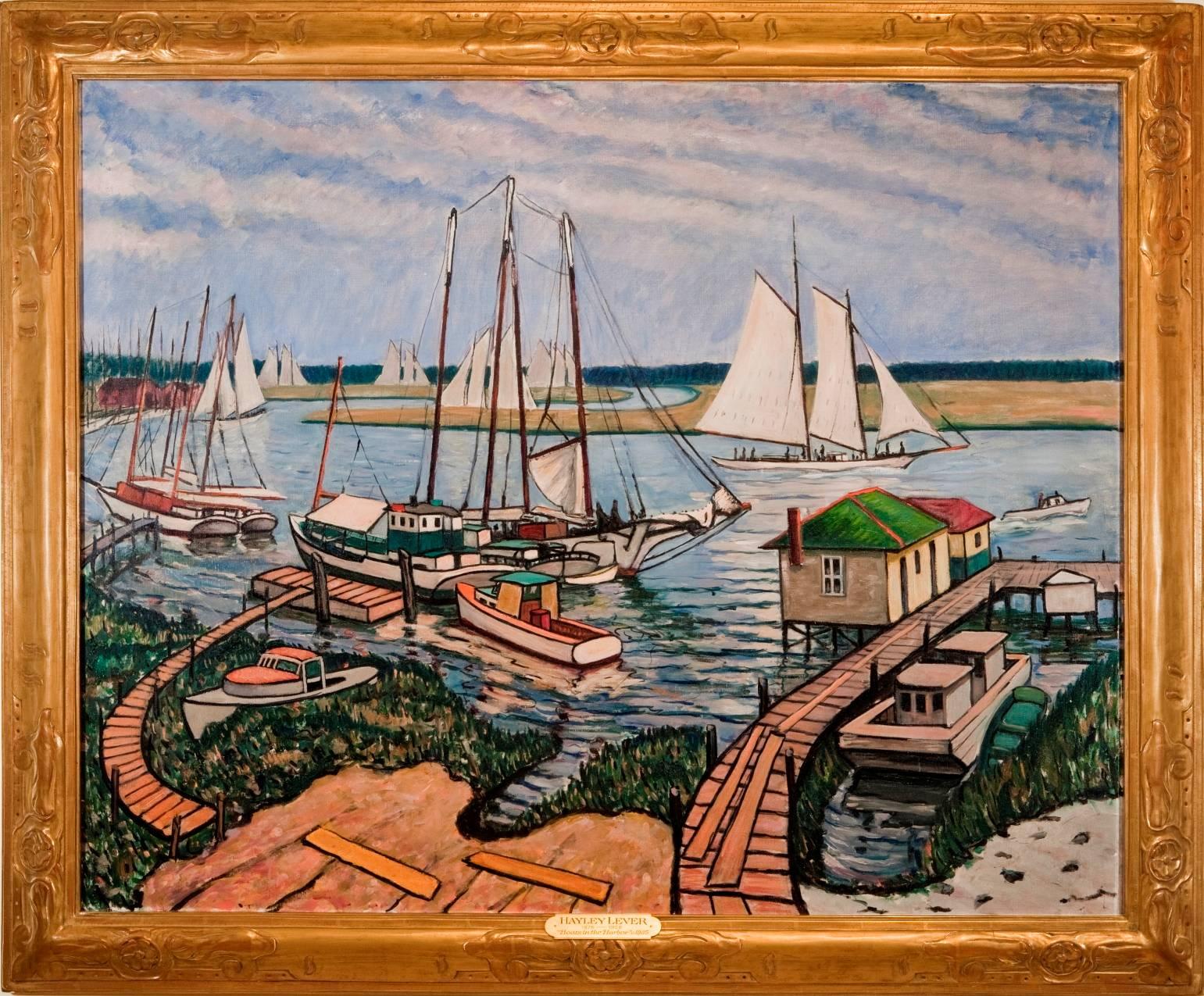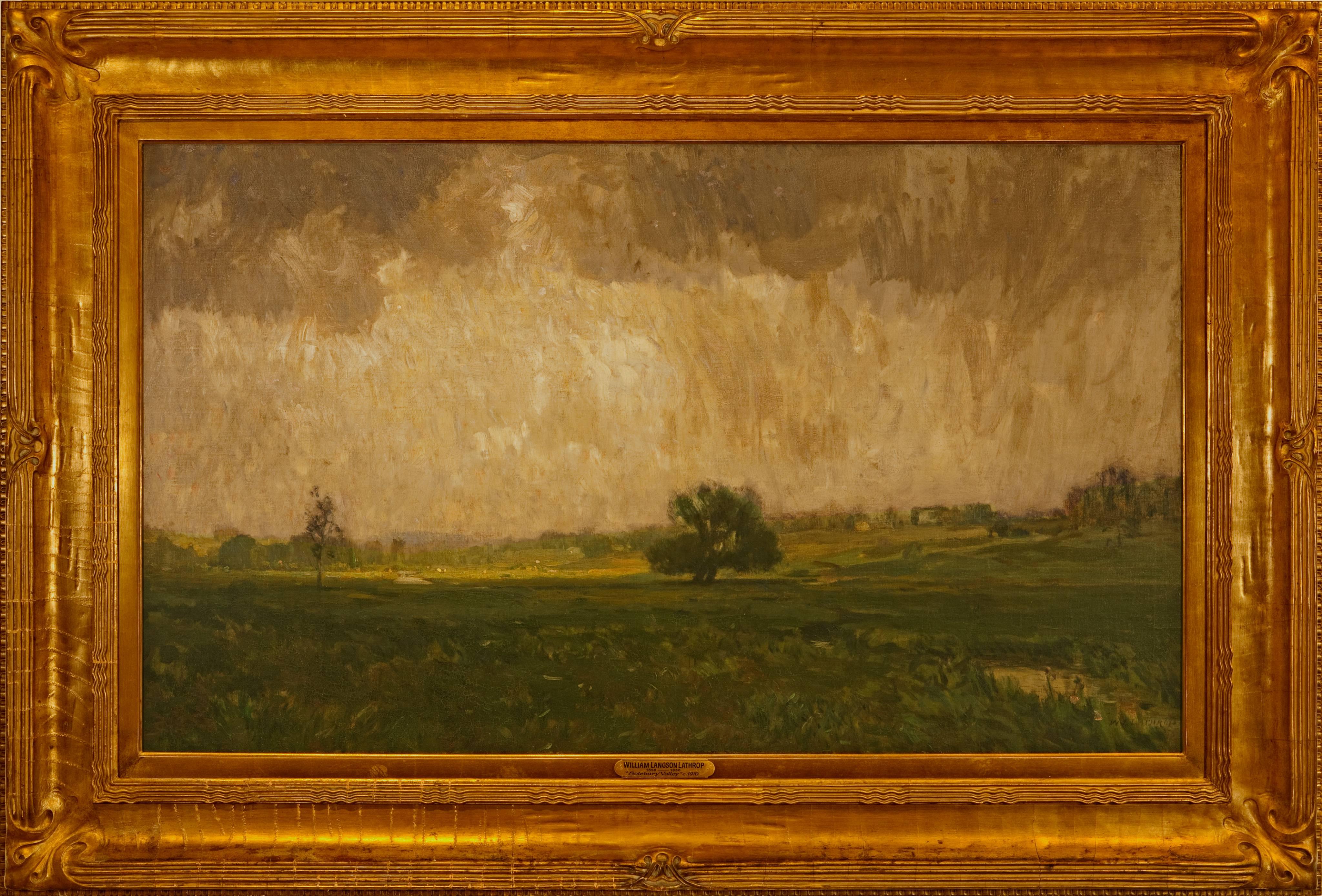Items Similar to 'The Coast at Bornholm', Paris, Charlottenborg, Bornholm School, Benezit
Want more images or videos?
Request additional images or videos from the seller
1 of 13
Mogens Hertz'The Coast at Bornholm', Paris, Charlottenborg, Bornholm School, BenezitCirca 1955
Circa 1955
About the Item
Signed lower left, 'Mogens Hertz' (Danish, 1909-1999) and painted circa 1955.
This Danish Impressionist artist first studied with the classically-trained Academician, Laurits Ring and, subsequently, with the notable Danish photographer and Impressionist painter, Rostrup Boyesen. After an influential study trip to Paris in 1930, Hertz continued his formal studies at the Charlottenborg Academy before moving from Copenhagen to the idyllic countryside outside Gudhjem. There, he became a founding, and leading, member of the Bornholm School and his work came to exemplify the group's lyrical portrayal of landscapes, painted in a loose and painterly, Impressionist style that can often border on abstraction.
From 1930-1941, Hertz traveled and studied widely, including in France, Holland, German, Norway and Sweden. He was the recipient of numerous prizes and juried awards including the August Schiøtt scholarship (1948) and the Frederik Sødring prize (1939). He also exhibited widely and with success including, for many years, at the Royal Danish Academy's Charlottenborg Spring Exhibition (from 1937), Sweden (1980), Bornholm Art Museum (1985) and the Vejen Art Museum (1983). Mogens Hertz is well-listed in art biographical reference works including Benezit.
We are pleased to offer a characteristically lyrical view of the picturesque Bornholm coast by this noted Danish Modernist.
Reference:
E. Benezit, Dictionnaire des Peintres, Sculpteurs, Dessinateurs, et Graveurs, Jacques Busse, 1999 Nouvelle Édition, Gründ 1911, Vol. 6, p. 954; Weilbach, Dansk Kunstnerleksikon, the Castle and Cultural Agency, Copenhagen; Chr. F. Beck i: Da. Kunst, nr. 90, maj 1950; Helge Ernst: Bornholmermalerne, 1984, 123f, 134; Lars Kærulf Møller i: Bornholms Kunstmus. Et udvalg af billeder, 1986, 42, 44; et al.
- Creator:Mogens Hertz (1909 - 1999)
- Creation Year:Circa 1955
- Dimensions:Height: 15 in (38.1 cm)Width: 24 in (60.96 cm)Depth: 0.75 in (1.91 cm)
- Medium:
- Movement & Style:
- Period:
- Condition:minor losses, minor restoration; unframed.
- Gallery Location:Santa Cruz, CA
- Reference Number:1stDibs: LU3447379002
About the Seller
5.0
Platinum Seller
These expertly vetted sellers are 1stDibs' most experienced sellers and are rated highest by our customers.
Established in 1982
1stDibs seller since 2013
637 sales on 1stDibs
Typical response time: <1 hour
- ShippingRetrieving quote...Ships From: Santa Cruz, CA
- Return PolicyA return for this item may be initiated within 3 days of delivery.
More From This SellerView All
- 'The Arc de Triomphe from the Champs-Élysées', Paris, France, Post-ImpressionistLocated in Santa Cruz, CASigned lower right, 'Boucher' (French, 20th century) and painted circa 1960. A bright and breezy, mid-century oil showing numerous shoppers and pedestrians outside the fashionable s...Category
1960s Impressionist Landscape Paintings
MaterialsOil, Canvas
- 'Montmartre in the Spring', Paris, Place du Tertre, Basilica of Sacre CoeurLocated in Santa Cruz, CASigned lower left, 'C. de Bruck' (?) and painted circa 1965. A view of the Place du Tertre in Montmartre with new, spring growth on the trees and various elegant figures shown walki...Category
1960s Impressionist Landscape Paintings
MaterialsCanvas, Oil
- 'Carmel Coast', California Plein Air Impressionist oil, Oakland Museum, StanfordBy Francis Harvey CuttingLocated in Santa Cruz, CASigned lower right 'F.H. Cutting' and dated '1932-1948'. Born in Iowa in 1872, Francis Harvey Cutting moved to San Jose, California in 1893 where he st...Category
1940s Impressionist Landscape Paintings
MaterialsOil, Board, Canvas
- 'Church of Elijah the Prophet, Yarolsavl City', Ilaskaya Church, Russia, OilLocated in Santa Cruz, CASigned, verso, in Cyrillic, 'Leontev V.E.' for Valentin Nikolaevich Leontiev (Russian, 1912-1984) and inscribed, 'City of Yarolsavl on the River Volga. Painter, Leontev V.E. Showing Ilaskaya Church, symbol of 17th Century architecture'. Painted circa 1965. Accompanied by old framing label bearing title, 'Church of the Prophet Elijah'. Displayed in a burnished gilt-wood frame; framed dimensions: 21.5 H x 17.5 W x 1.5 D inches Valentin Nikolaevich Leontiev; painter, teacher. Honored Worker of Culture of the USSR (1973). Member of the Great Patriotic War of 1941-1945. He was awarded a commemorative medal. Medal "For Valiant Labor. In commemoration of the 100th anniversary of the birth of V.I. Lenin. Member of the Union of Artists of Russia (1947). Chairman of the Board of the Yaroslavl Union of Artists (1961-1964), member of the board until 1982. In 1931 he graduated from the Yaroslavl Art and Pedagogical College (teacher - S.F. Shitov) and continued his studies in Leningrad (teachers - I.I. Brodsky, A.A. Osmerkin, B.V. Ioganson). He was a Stalin scholarship holder. In 1941, from the 6th graduation course of the institute at the Academy of Arts, he volunteered for the front. Participated in battles near Narva and Kingisepp (North-Western Front). When the regiment left the encirclement, he was captured, in April 1945 he was liberated by the allied forces in Germany on the river. Elbe. After his release, he fought on the 2nd Belorussian Front, participated in the battles near Königsberg. In 1947 he graduated from the Leningrad Institute of Painting, Sculpture and Architecture. I.E. Repin of the Academy of Arts of the USSR, having defending his thesis - the monumental composition "Meeting of the Winners". After graduation, he taught at the Cheboksary (Chuvash ASSR) art school (1949-1951). In 1951 he returned to Yaroslavl and for 32 years (1951-1983) taught at an art school. There are many well-known artists among the students of Valentin Nikolaevich Leontiev. In addition to many landscapes ( " Morning in Yaroslavl " (1967), " Industrial motive " , " The Church of Elijah the Prophet " (1956), " Hoarfrost "(1979) and others), as well as chamber works in the genre of still life, V.N. Leontiev created several significant thematic canvases, including: " Weekend Morning in Cheboksary " (1950 - Chuvash State Art Museum), " Building Communism " (1951, YAHM). Participant of regional, interregional, zonal, regional, republican and all-Union exhibitions. Personal exhibitions in Yaroslavl: 1972, 1983 and 1997. V.N. Leontiev participated in the work of several congresses of the Union of Artists of the RSFSR and the Union of Artists of the USSR, in the formation of regional exhibitions. Works by V.N. Leontiev are kept in the museum collections of Yaroslavl, in Russian and foreign private collections. From the introductory article to the exhibition catalog "Valentin Nikolaevich Leontiev and his students ” , 2008 Art critic Olga Shikhanova. He was loved by both students and fellow artists. Many even now remember with a smile many funny stories associated with the name of Valentin Nikolaevich Leontiev, one of the most significant painters of Yaroslavl. Many are still grateful to him for the lessons of mastery, for patience and tolerance, for a sincere interest in their first, albeit timid, steps in art and for a personal example of passion for creativity. A native Yaroslavl, Leontiev was born on February 5, 1912. His father was a wagon coupler on the railroad and died when his son was 7 years old. Mother Alexandra Nikolaevna worked all her life as a painter at one of the oldest paint and varnish enterprises in the country - the Victory of Workers plant. An inquisitive and active boy at the age of ten joined the first pioneer detachment on Krasny Perekop and from that time became addicted to drawing. Valentin received his initial art diploma in the then popular working studios of fine arts, and in the Yaroslavl Art School, where he entered in 1928, his teachers were wonderful teachers Sergei Fedorovich Shitov and Pyotr Nikolaevich Shadrikov, who stood at the origins of the Yaroslavl art school. In 1931, after defending his diploma, Leontiev received a referral to the Victory of Workers factory, where he conscientiously performed the usual work for a factory artist: he wrote slogans, drew wall newspapers, designed stands with the results of socialist competitions. Such work could not give real creative satisfaction to a person with his pictorial possibilities. In 1933, Valentin first entered the preparatory classes of the All-Russian Academy of Arts, and in 1935 became a student. Art and creative work carried away, and the names of the teachers I. Brodsky, A. Osmyorkin, B. Ioganson, E. Serov, R. Frentz, A. Zaitsev, who had already entered the history of Russian art, turned their heads. In 1940, for excellent progress, Vadentin was awarded the highest student award - a state scholarship. Even then, Leontiev's leadership qualities appeared, and in 1938 he was elected a member of the Student Youth Council under the Central Committee of the Komsomol. For the diploma, he painted a large-scale painting "Children on the Volga" (headed by A.I. Savinov). These few Leningrad years were the happiest in Leontiev's life. After all, it was there, within the walls of the Academy, that he met a friend for life - Evsey Moiseenko, and there he met his only love, Tanya Edelson. The wedding was played in a student hostel in January 1941. But June 1941, like many young people of his generation, dramatically changed the life that had begun so wonderfully. The terrible word "War!" Leontiev and Moiseenko, academic scholarship holders, on whom great hopes were placed, were completely exempted from military service, but both made the only choice possible for them at that time: instead of defending their diploma, in July 1941 they signed up as volunteers in the people's militia. On a memorable day, a large group of students gathered at the Academy - future historians, artists, musicians - all of whom the slogan "Leningrad is in danger!" also did not leave indifferent. From there, everyone went first to the militia, and then to the front. Private of the 4th Volunteer Division, Leontiev participated in the construction of defensive fortifications around Leningrad. The militias dug the ground, constructing anti-tank ditches and pillboxes. After heavy fighting near Narva and Koenigsberg, some colonel undertook to take them out of the encirclement. And so it happened that led untrained soldiers directly to the Germans. So Leontiev was captured, and soon ended up in Germany. Repeated attempts to escape each time ended in raids and brutal reprisals. Finally, he was given as free slaves to a German farm, where he stayed until the arrival of the Red Army. It was a difficult time for Leontiev's wife, Tatyana: in November 1941, their son Vladik was born in Anapa. She survived nine months of occupation and the inability to learn anything about the fate of her husband. Freed from captivity, Leontiev served in the 128th separate communications battalion of the 24th Army of the Belorussian Front until October 1945, and all this time he tried to contact his relatives. He was considered missing. Finally, Valentin was reunited with his family, and then a wonderful portrait of his son appeared, which the artist painted on the same day - “Vladik. Meeting with my son. Leontiev's graduation work was lost during the war years. Having written under the guidance of B.V. Ioganson and V.A. Serov's new large painting "Meeting of the Winners" (280x350), Valentin in 1947 defended his diploma. The high commission rated...Category
1960s Impressionist Landscape Paintings
MaterialsCanvas, Oil
- 'Autumn, Sunrise over Mt. Tom', Santa Barbara Artist, Ventura Art Museum, OilBy Richard SchlossLocated in Santa Cruz, CASigned lower right, 'R. Schloss' for Richard Schloss (American, born 1953) and dated 2014; additionally signed, dated and inscribed, verso. This notable California artist received ...Category
2010s Impressionist Landscape Paintings
MaterialsCanvas, Oil
- 'Sunny Afternoon, Hyères, Côte d’Azur', French Riviera, Royal Academy of Art OilLocated in Santa Cruz, CASigned lower right, "C. Stilling" for Carl Conrad Stilling (Danish, 1874-1938) and inscribed 'Hyères'; dated lower left, '1928' and titled in Danish, verso...Category
1920s Impressionist Landscape Paintings
MaterialsCanvas, Oil, Wood Panel
You May Also Like
- At the ClotheslineBy Irving Ramsey WilesLocated in New York, NYSigned lower right: Irving R. WilesCategory
Late 19th Century American Impressionist Landscape Paintings
MaterialsCanvas, Oil
- "Sunday in the Park, 1910"By Cyprien Eugène BouletLocated in Lambertville, NJSigned Lower Right Cyprien-Eugène Boulet (1877 - 1927)Category
Early 20th Century Impressionist Landscape Paintings
MaterialsCanvas, Oil
- "Boats in the Harbor"By Hayley LeverLocated in Lambertville, NJOriginal Period Frame Hayley Lever (1876 - 1958) Hayley Lever's exceptional career path took him from the shores of his native Australia to those of England, and then the United S...Category
1930s Impressionist Landscape Paintings
MaterialsCanvas, Oil
- "Alley Fiends"By John R. GrabachLocated in Lambertville, NJJim’s of Lambertville is proud to offer this artwork by: John R. Grabach (1886 - 1981) John Grabach was a highly regarded New Jersey artist, teacher, and author of the classic text...Category
1930s American Impressionist Landscape Paintings
MaterialsCanvas, Oil
- "Forest Strongholds"By John F. CarlsonLocated in Lambertville, NJSigned lower right. Complemented by a hand carved and gilt frame. Exhibited at the National Academy of Design, 1928Category
20th Century American Impressionist Landscape Paintings
MaterialsCanvas, Oil
- "Solebury Valley"By William Langson LathropLocated in Lambertville, NJSigned lower right. Complemented by a period frame. William L. Lathrop (1859-1938) Deemed “Father of the New Hope Art Colony”, William Langson Lathrop was born in Warren, Illinois. He was largely self-taught, having only studied briefly with William Merritt Chase in 1887, at the Art Students League. Lathrop first moved east in the early 1880s, and took a job at the Photoengraving Company in New York City. While there, he befriended a fellow employee, Henry B. Snell. The two men became lifelong friends and ultimately, both would be considered central figures among the New Hope Art Colony. Lathrop's early years as an artist were ones of continuing struggle. His efforts to break through in the New York art scene seemed futile, so he scraped enough money together to travel to Europe with Henry Snell in1888. There he met and married an English girl, Annie Burt. Upon returning to New York, he tried his hand at etching, making tools from old saw blades...Category
1910s American Impressionist Landscape Paintings
MaterialsCanvas, Oil
Recently Viewed
View AllMore Ways To Browse
Swedish School
French Classical School
Danish Modernist Art
Danish School Painting
Vintage Bornholm
Landscapes By Danish Artists
German Classical School
Castle 1950
Coast Ring
Danish Impressionists
Danish Impressionist Painting
Moller 6
Norwegian Impressionists
French Countryside 1930
Modernist Landscape Swedish
Moller Painting
Dutch Countryside Painting
Norway Ring





